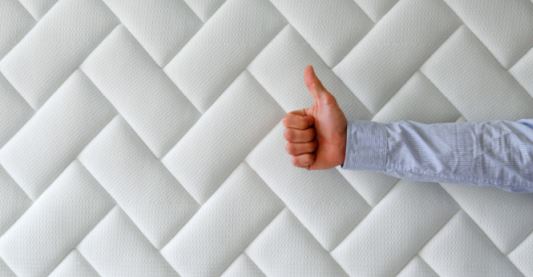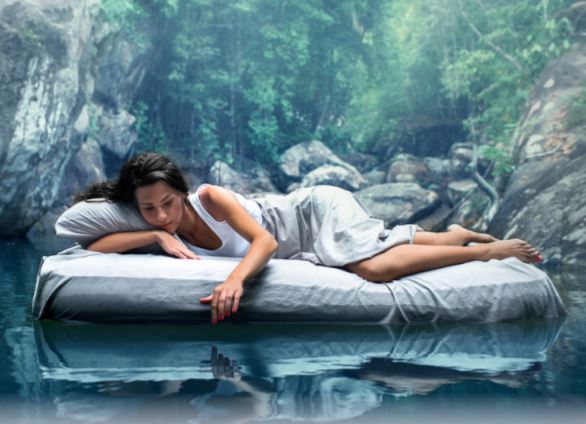A customer walks into a Home decor showroom in Hyderabad. She is greeted by an enthusiastic retail offline store salesman who talks to her to understand what the customer is looking for. It appears that the young lady who just moved into the city is looking for a mattress, curtains, upholstery, a sofa and some kitchen utilities. She is ushered into the well-decked retail showroom having four floors dedicated to each department. The customer is taken to a kiosk where an image of a typical bedroom is rendered and the customer interacts with the kiosk to change the wall colours to that of her own bedroom, change the bed size, place mattresses, upholsteries and all the paraphernalia to experience how it will finally appear when bought and decked in her own home.
Once she is satisfied, she is taken to the section where the bed and mattresses are displayed. Here she sees another kiosk and out of curiosity, she starts interacting with it. As she presses the buttons, she sees to her astonishment the headboard of the bed change – slowly moving over a pair of rails and aligning with the bed. She checks various headboards and suddenly she feels that she has to change her bed because she liked the headboard on display. She then picks up the mattress, linen and upholstery she already checked at the earlier kiosk. Now, she comes to the sofa section, and again a kiosk helps her select the sofa type, the material and the design and shape. The moment she chooses these, a spotlight switches on showcasing the actual physical sofa in all its glory. There is much time spent this way and selections made.
We are not describing some movie scene from an imagined futuristic real experience but an actual offline retail experience being built by a leading home decor company in India. These stores are coming up across the country. Each major city sports one experience store of this kind.
Why are we highlighting this? Offline Retail showrooms are finding new ways to attract footfalls and actual purchases of goods. The advent of online shopping in the past couple of years has had some impact. However, looks like post-pandemic people are more eager to step out and get an actual feeling of offline retail stores.
“We perhaps did not realize this but after Covid customers are delighted to come to our showroom and touch and feel the products and purchase,” says Prasanna Kumar, owner of the Kurtano retail showroom.
Duroflex is also making some innovative upgrades to its in-store experience in the mattress industry. Here’s a short tour of what companies can actually do to increase footfall and sales.
|| Some in-store experiments
IKEA showrooms offer a unique experience to the customer. The showrooms are designed to be a place where customers can experience the products in a way that is not possible in a traditional retail store. The showroom design is intended to make the customer feel comfortable and at home, while also providing an environment that allows them to easily navigate through the offline showroom.
IKEA stores are easily navigated by customers and only have a few main aisles with branches leading off. The offline store is laid out in a grid pattern, with the most popular items stocked at eye level to attract impulse purchases. The retailer has also been praised for its recycling policy.
OFFLINE RETAIL SHOWROOMS ARE FINDING NEW WAYS TO ATTRACT FOOTFALLS AND ACTUAL PURCHASES.POST PANDEMIC PEOPLE ARE MORE EAGER TO STEP OUT AND GET AN ACTUAL FEELING.
Maruti Nexa showrooms are also adopting a strategy for delivering the highest degree of customer experience.
“The Nexa showrooms are designed to be a place where you can experience the latest technology and products, we are excited to be able to offer our customers a new way to shop for their next vehicle,” says a Nexa Showroom executive in near Jubilee Hills in Hyderabad.
The classic example is that of Apple stores. Apple stores are created to be a place where people can come to learn about and purchase Apple products. The offline stores are designed to be easy to navigate, with the products displayed in an attractive manner. The Genius Bar, an offline in-store counter in every Apple Store, helps customers to learn how-tos and upgrade from experts.
|| Technologies to the aid
A luxury lighting range of the offline Retail showrooms is able to increase walk-ins through the adoption of iPhone and Android apps. The company has also launched a new website which will be the primary source of information for consumers interested in purchasing products from the brand.

SOME SHOWROOMS IN NEW DELHI ARE MAKING ELABORATE PLANS TO USE IOT AND VR TECHNOLOGIES TO HELP CUSTOMERS VISUALIZE THEIR HOMES WITH FURNITURE AND ACCESSORIES.

Luxury retailers are also working on new versions of their mobile apps, using which customers can make payments using contactless payment options. They are also loading up the apps with a lot more features that are going to make it easier for customers to browse products, select, and buy. The showroom is the experience centre and proof of truth and experience. Just to remind you, these are offline retail showrooms we are talking about.
Some showrooms in New Delhi are making elaborate plans to use IoT and VR technologies to help customers visualize their homes with furniture and accessories. Such technology is also being used to help people with disabilities, such as blindness or deafness, experience the world around them. For example, a VR headset can be used to simulate what it’s like to see in 3D.
Now much excitement is simmering as Meta (erstwhile Facebook) announced that they are going to have their Oculus VR Headset showrooms all over the world. Well, that’s a big thumbs up for VR-enabled offline stores and how they can be used to enhance the augmented reality experience in offline stores.
|| Sleep Experience Stores
Mattress companies are opening sleep experience offline stores and the mattress industry is growing at a rate of an estimated 10 percent per year in India. The sleep experience stores are designed to be immersive, interactive experience centre that allows customers to try out different mattresses in a variety of settings. The goal is to help customers find the right products.
Sleep Experience offline stores are deploying advanced technologies to help customers find the right mattress. The sleep experience is now a fairly old retail concept that combines the best of traditional mattress stores with the latest in technology and customer service. However, with equipment that can measure and record postures, pressure points on the body while sleeping, and sleep quality, these stores are transforming into sleep clinics.
|| Mind the Message
Mattress companies are building experience stores that are more like showrooms, where you can try out the mattresses and then order them online. Add to this the advent of technology and luxury experience stores can now be replicated everywhere. Offline stores will actually end up having an advantage over online.


